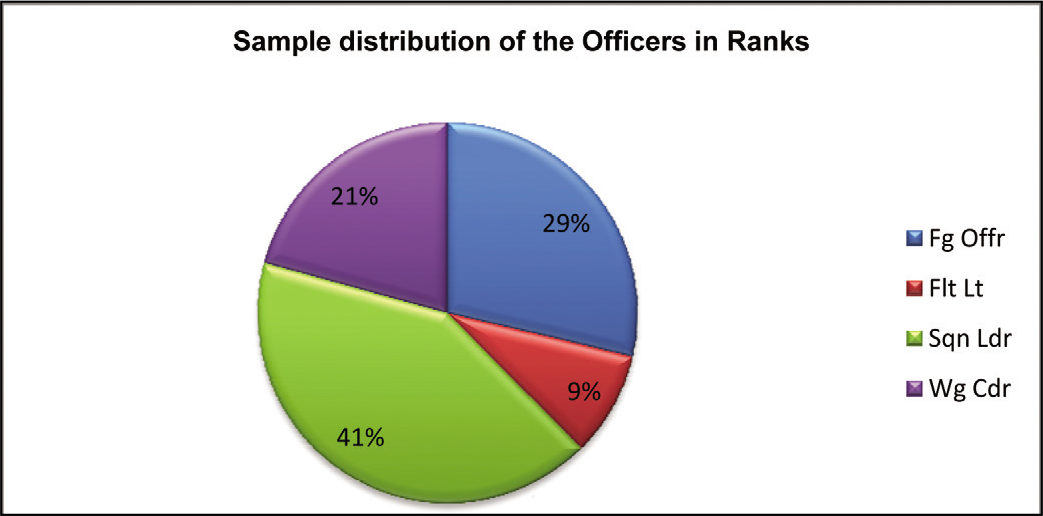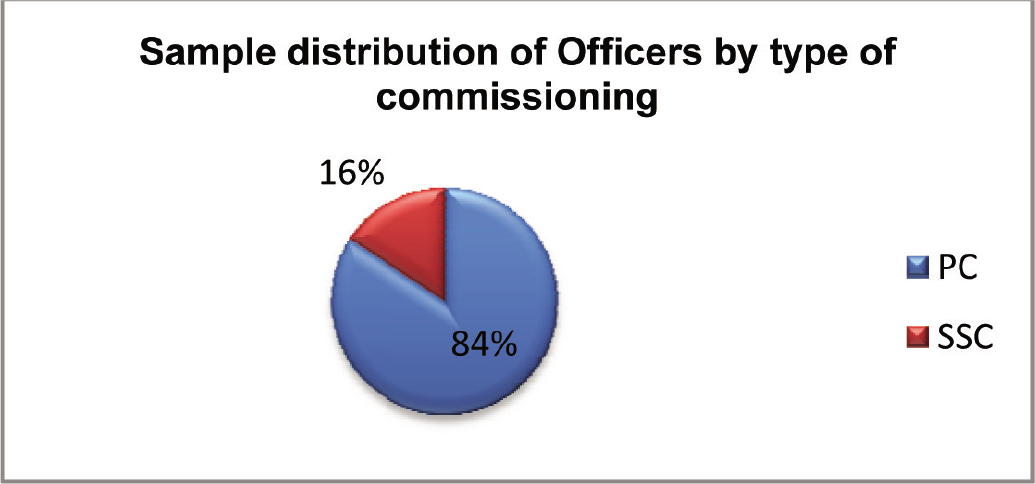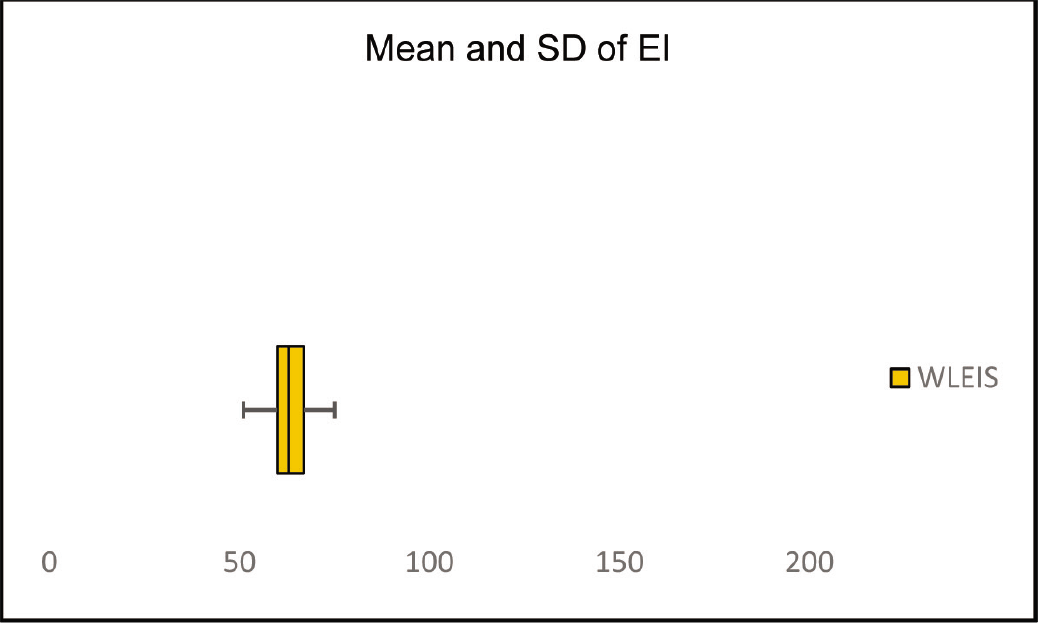Translate this page into:
Feeling Side of Intelligence among IAF Fighter Pilots
Abstract
Background:
Trait Emotional Intelligence (EI) has been referred as an individual’s self-perceptions of their emotional abilities. Research states that dimensions of EI like Self-awareness, awareness about others, control and regulation of emotions are essential in individuals. In high stress and high-risk environment like aviation, EI among air warriors helps in achieving a balance between high performance and interpersonal relationships. The current paper discusses the level of Trait EI among Indian fighter pilots.
Method:
A self-report questionnaire of Wong and Law Emotional Intelligence Scale (WLEIS) was used to assess the trait EI. WLEIS measures trait EI and its four dimensions viz. Self-Emotion Appraisal (SEA), Others’ Emotion Appraisal (OEA), Use of Emotion (UOE) and Regulation of Emotions (ROE). The sample consisted of male fighter pilots (n=101) of different ranks and flying experience.
Results:
Descriptive statistics indicated thatparticipants have reported high levels of trait EI. They had scored high on SEA dimension as compared to OEA, UOE and ROE. It was also found that there was no significant difference between Flying Officers and Wing commanders of this data in the independent samples t-test. The paper discusses role of EI in aviators and suggests enhancing EI for augmenting performance and flight safety.
Keywords
Emotional Intelligence
Self-Emotional Appraisal
Use of Emotion
Regulation of Emotion
“It is only with the heart that one can see rightly; what is essential is invisible to the eye.”
- Antoine de Saint-Exupery
Introduction
The distal roots of Emotional Intelligence (EI) can be traced back to Thorndike’s (1920) social intelligence, which concerned the ability to understand and manage people and to act wisely in human relations [1]. Its proximal roots lie in Gardner’s (1983) work on multiple intelligences and, more specifically, his concepts of intrapersonal and interpersonal intelligence [2]. By contrast, “intrapersonal intelligence involves the capacity to understand oneself, to have an effective working model of oneself—including one’s own desires, fears, and capacities —and to use such information effectively in regulating one’s own life” [3].
The concept of EI has aroused great interest among researchers and professionals working in the field of mental health [4]. Bor and Hubbard [5] have stated that mental health should be assessed since it has been established that there is a correlation between flight safety and pilot’s emotional status. Within the area of EI, Mathews, Roberts, Zeidner [6] opined that “the range and scope of definitions that currently exist within the literature make inevitable comparisons between the science of EI and the allegory underlying the Tower of Babel” [7]. Mayer and Salovey (1997) define EI as the ‘‘ability to recognize the meanings of emotions, reason and solve problems based on them, thus pursuing a cognitive character’’ [8].
EI in Indian Military Context
Colonel Rajeshwar Singh of Indian Army, has written about application of EI in army units and formations operating in counter insurgency operations. He posited that the performance of a soldier who is engaged all 24 hours fighting militancy for months together needs serious thought. The conventional theories need to be supplemented with latest concepts. There are no magic remedies to combat ‘stress’ but EI is promising to be a new propelling force to enhance performance by not only lowering down the stress levels but drive them on the path of achievement [9]. Colonel Vikram Singh [10] suggested that a retrospective analysis of certain cases may give insights regarding the selection process, management of EI and can help in bringing down the suicide cases to a very large extent.
Further Studies carried out in USAF on EI found that the potential recruiters required higher levels of EI. The USAF in a study [11] realized that “by using EI to select the recruiters, they increased their ability to predict successful recruiters by “three fold” and through the recognition that EI is important to the potential of new recruiters, they could save money to the exchequer.
Wong and Law elucidated that EI is an ability to be aware of one’s own emotions and those of others and to manage emotions in different situations and they proposed that EI comprises of four dimensions namely Others’ Emotion Appraisal (OEA), Use Of Emotion (UOE), Self-Emotion Appraisal (SEA), and Regulation Of Emotion (ROE) [12].
Theorists who proposed EI concepts have put forth that one’s physical and mental health as well as one’s career is affected by EI [12]. Low EI would be expected to add to a broad range of symptoms of psychopathology, as well as anxiety and depression. Low EI should be related with deficits in the ability to correctly perceive the emotions and intentions of others, poor ability to recognize feelings and their true antecedents, and limited ability to adjust mood and emotional reactions through voluntary means [13]. In this model, even cumulative minor daily hassles and stresses could lead to exaggerated reactions among those with lower EI, culminating in anxious or depressive experiences. Thus, interventions aimed at improving EI may help develop the skills necessary to remain resilient against stress and maintain greater mental health and well-being [14]. EI offered a new perspective in the study of emotions, which has gone from being considered distractions in human cognitive processes to being perceived as vital factors that provide useful information for solving everyday problems. Following this approach, the management of our emotions is now considered vital for health and psychological adaptation.
Petrides and Furnham [14, 16] distinguished between trait EI (or emotional self-efficacy) and ability EI (or cognitive-emotional ability) based on the fundamental psychometric distinction between measures of typical and maximal performance. It is important to understand that trait EI and ability EI are two different constructs. The former is measured through self-report questionnaires, whereas the latter ought to be measured through tests of maximal performance.
Thus it is evident that EI has numerous constructs and assesses diverse individual abilities or traits rather than being a single construct. This distinction in both the models have been highlighted as trait EI is found to be highly correlated with personality traits and the ability EI correlates highly with coping skills and regulation of emotions. Thus, the objective of this research paper is to assess the level of trait EI among Indian Air Force fighter pilots.
Material & Methods
The research is planned as a cross-sectional study and the sample consisted of a (n=101) male fighter pilots in the age range of 21 - 45 years who participated voluntarily in this study. They were explained about the protocol of the study in detail. The ethical committee of the Institute had approved the test protocol. The demographic characteristics of the group are listed below in Table 1.
| Characteristic | Mean | SD |
|---|---|---|
| Age | 29.81 | 6.97 |
| Service in years | 7.95 | 6.08 |

- Sample distribution of the Officers in Ranks (n=101)

- Sample distribution of the Officers by the type of commissioning (n=101)
The Wong and Law EI Scale was developed by Wong and Law in 2002. It consists of 16 self-report statementsand response was obtained on a five-point Likert scale. Studies conducted by Kim and Agrusa[17] substantiated the reliability and validity of WLEIS. The questionnaire was freely available in public domain. Moreover, as the scale was developed through Chinese respondents in Hong Kong, it can be considered as a better starting point for other Asian cultures than EI scales developed in the Westerncountries[18]. It has four dimensions: Self-Emotion Appraisal (SEA), Others ’Emotion Appraisal (OEA), Use of Emotion (UOE) and Regulation of Emotion (ROE).
The first dimension Self-Emotion Appraisal (SEA), measures the ability to become aware of and convey one’s own deep emotions naturally.
The second dimension Others ’Emotion Appraisal (OEA), is being able to perceive and recognize the emotions of those people around them.
The third dimension, the Use of Emotion (UOE) is being able to apply one’s own emotion information in one’s own performance and productive activities.
The fourth dimension, Regulation of Emotion (ROE) is being able to regulate one’s own emotions in a given situation by behaving in an appropriate way.
It has adequate internal consistency (r = .78 to .89) with similar consistency of the subscales. It has also exhibited a small incremental validity over Intelligent Quotient (IQ). The reliability score of Cronbach’s Alpha has been .70 -.85. It has predictive validity on Job performance and Satisfaction, Organizational Commitment and Turnover Intention. The four factors have a global score. It was found that the WLEIS predicted task and avoidance [19]. Kong, Zhao and You [20] found out that the effects of the scale on mental distress were partially mediated by negative and positive effect although the scores of WLEI Shad accounted for unique variance in this model.
A good rapport was established with the air warriors, the participants were given two self-report questionnaires along with the demographic inventory and asked to mark their opinion on the response sheet. The respondents were briefly explained about the need and purpose of the study and were assured of confidentiality. On both the questionnaires they were asked to indicate how much they agreed or disagreed with the statements on a five point Likert Scale from “Strongly Disagree”, “Disagree”, “Undecided” to “Agree” and “Strongly Agree” and mark the point on the scale. Administering both the tests took 10 – 15 minutes approximately. The questionnaires were then scored by hand. The data was then entered into SPSS v20 software for the analysis of data. Descriptive statistics were drawn on all the study variables.
Results
The descriptive statistics of the group on WLEIS variables are depicted in the following table:-
| Variables | Mean | SD | Min | Max | Range |
|---|---|---|---|---|---|
| EI | 63.17 | 5.4 | 51 | 75 | 24 |
| SEA | 55.13 | 18.02 | 11 | 74 | 63 |
| OEA | 15.04 | 2.41 | 8 | 20 | 12 |
| UOE | 16.54 | 2.07 | 12 | 20 | 8 |
| ROE | 15.50 | 2.32 | 7 | 20 | 13 |
The participants of the study scored high on trait EI when compared to normative data. Out of all the four dimensions of WLEIS, they had scored high on SEA i.e. 55.13 and in the other three dimensions such as OEA, UOE and ROE they had mean values of 15.04, 16.54 and 15.50 which can be interpreted as average.

- Box plot of mean and SD
Discussion
The results showed that the sample reported high level of EI. Further, high score on SEA and self-awareness shows that these individuals have an ability to perceive one’s own emotions. They are clear about what they feel and able to decode other people’s emotional expressions. It can be stated that Self-awareness is the start point to EI, as being aware of oneself will pave way to understanding others. Aviators with higher levels of EI make use of their emotional regulation mechanisms effectively to create positive emotions as well as to promote emotional and intellectual growth. As it is evident from, SunTzu’s crisp observations about both self- awareness and awareness of others, that an individual with knowledge of self as well as the opponent will win.
Aviators in this study reported average levels of regulation of one’s emotion. ROE measures short, medium and long-term control of one’s own feelings and emotional stress. So, pilots with a high score are said to have control over their emotions and being able to change unpleasant moods or prolong pleasant moods through personal insight and effort. They are also psychologically stable and know how to pick themselves up after emotional setbacks. Low scores on the other hand are subject to emotional seizures and periods of prolonged anxiety and depression. They find it difficult to deal with their feelings and are often moody and irritable. Studies have stated that this can even lead to deterioration of mental health [14]. By the nature of their job, aviators are exposed to intense emotions. Therefore, they must possess knowledge of regulating their emotions so that the emotions are unable to hijack their rational thinking and performance. They also must get opportunities to vent out their feelings so that they do not get under an emotional stress. The knowledge of emotional interaction within the brain can certainly help them to retain their sense of rationality even under situations of intense pressure. This can easily be achieved through formal training on raising the EI. The aviators would not only gain personally by raising their EI but will also have a profound influence on their subordinates. This would have a great impact on the group performance, thereby making the flying more effective and safe.
Conclusions
It can be concluded that these results can make considerable contributions to the aviation sector about trait EI of fighter pilots and can have a bearing on the conduct of pilots while discharging their duties and interacting with personnel. EI will help the aviators ‘choose their battles wisely’. The study suggests that practical ways of improving one’s EI may be incorporated in various training courses as attitude and emotional regulation complements the skill of flying.
References
- Frames of mind In: The theory of multiple intelligences. New York: Basic Books; 1983.
- [Google Scholar]
- Measuring Trait Emotional Intelligence In: Schulze R, Roberts RD, eds. Emotional Intelligence An International Handbook. Ashland: USA: Hogrefe & Huber; 2005.
- [Google Scholar]
- Emotional Intelligence and Personality Traits as Predictors of Psychological Well-Being in Spanish Undergraduates. Social Behaviour and Personality. 2010;38(6):783-94.
- [Google Scholar]
- Aviation Mental Health In: Psychological Implications for Air Transportation (1st ed). Cornwall- Routledge; 2006.
- [Google Scholar]
- Seven myths about emotional intelligence. Psychological Inquiry. 2004;15(3):179-96.
- [Google Scholar]
- Emotional Intelligence A Literature Review. University of the Pacific Department of Psychology.
- [Google Scholar]
- What is emotional intelligence? In: P Salovey, D. Sluyter, eds. Emotional development and emotional intelligence. Educational Implications for educators. New York: McGraw Hills; 1997. p. :3-31.
- [Google Scholar]
- Application of Emotional Intelligence in Army Unitsand Formations Operating in Counter Insurgency Operations. (dissertation). Hyderabad: Osmania University;
- [Google Scholar]
- Emotional Intelligence and Its Relevance in the Armed Forces. (dissertation). Hyderabad: Osmania University;
- [Google Scholar]
- The Business Case for Emotional Intelligence. [Internet] [Cited 2016 Feb 22] Available from: http://www.eiconsortium.org/pdf/business_case_for_ei.pdf
- [Google Scholar]
- The effects of leader and follower emotional intelligence on performance and attitude: An exploratory study. The Leadership Quarterly. 2002;13:243-274.
- [Google Scholar]
- Mayer-Salovey-Caruso Emotional Intelligence Test (MSCEIT) user’s manual North Tonawanda, NY: Multi-Health Systems; 2002.
- [Google Scholar]
- Emotional Intelligence Partially Mediates the Association between Anxiety Sensitivity and Anxiety Symptoms. Psychological Reports. Sage Publications. 2016;118(1):23-40.
- [Google Scholar]
- Gender differences in measured and self-estimated trait emotional intelligence. Sex roles. 2000a;42:449-61.
- [Google Scholar]
- On the dimensional structure of emotional intelligence. Personality and Individual Differences. 2000b;29:313-20.
- [Google Scholar]
- Trait emotional intelligence: Psychometric investigation with reference to established trait taxonomies. European Journal of Personality. 2001;15:425-48.
- [Google Scholar]
- Hospitality service employees’ coping styles: The role of emotional intelligence, two basic personality traits, and socio-demographic factors. International Journal of Hospitality Management. 2011;30(3):588-98.
- [Google Scholar]
- Theory and Measurement of Trait Emotional Intelligence In: The Wiley Handbook of Personality Assessment (1st ed). 2016.
- [Google Scholar]
- Affective mediators of the relationship between trait emotional intelligence and life satisfaction in young adults. Personality and Individual Differences. 2012;54(2):197-201.
- [Google Scholar]






